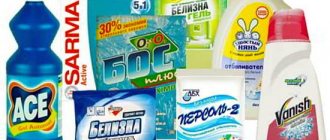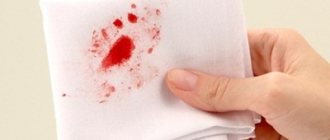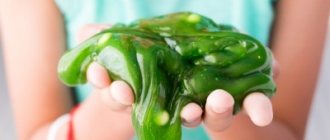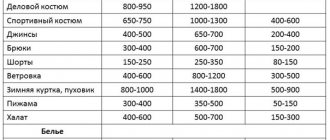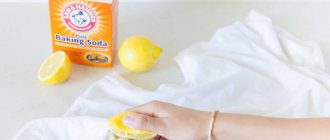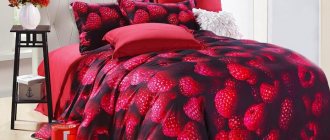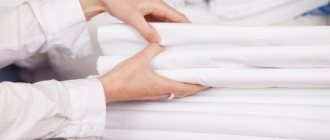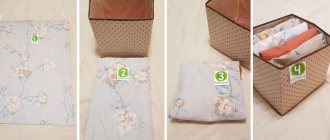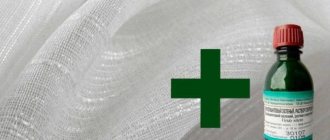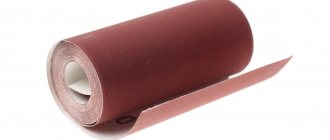Store-bought bleaches: which one to buy
To make the right choice, you need to study the range offered by manufacturers and the mechanism of action of various products.
- Chlorine. As a result of a chemical reaction of the active component (sodium hydrochloride), active oxygen is released, which is a bleaching agent.
- Optic. Contains luminescent dyes that create an optical illusion: the laundry looks snow-white, but in fact it is not.
- Oxygen. As a result of a chemical reaction of the active component (hydrogen peroxide, potassium peroxosulfate, sodium or potassium peroxocarbonate), active oxygen is released, which, being a powerful oxidizing agent, eliminates contaminants.
The pros and cons of different types of bleaches are described in the table below.
Table - Advantages and disadvantages of professional bleaches
| Bleach type | Behind | Against |
| Chloric (White, Ace) | - Affordable price; — high-quality disinfection; - whitens even in cold water | — Damages the fabric, reduces strength; — not suitable for automatic washing; — caustic fumes can cause irritation and poisoning; — used only when washing items made of cotton and linen, not suitable for delicate fabrics and synthetics |
| Optical (“OV-1”) | — Possibility of achieving the effect of dazzling whiteness | - Works only on clean things; — does not remove stains and stains; - does not rinse out of fabric |
| Oxygen (“ecO2”, “Selena”, “Persol”, Extra, Shabondama) | — Delicate removal of contaminants; — possibility of use at low water temperatures; — helps to whiten laundry at home effectively; - completely rinses out of the fabric; — provides good disinfection; - can be mixed with powder when machine washed | - High price |
How to use
When buying bleach, it is better to give preference to products without chlorine. When using oxygen fabric bleach or optical bleach, it is recommended to strictly follow the instructions on the package, since the dosage and method of application for hand and machine washing may differ.
Often housewives “the old fashioned way” use the most affordable chlorine bleach - whiteness, considering this product to be effective and the best. However, you need to remember that frequent use of bleach can have a bad effect on the condition of the fabric and you should only use it when hand washing cotton and linen items. To bleach things white, be sure to wear rubber gloves and follow these four steps.
- Stir 100-200 g of grated brown soap (72%) into 10 liters of warm water.
- Add white to the composition (a tablespoon per 3 liters of solution).
- Leave the laundry in the prepared product for 15-20 minutes.
- Rinse thoroughly in clean water.
Tips for people who sweat
In order to still avoid soiling your clothes, you should also take care of yourself.
Be sure to use body deodorants. It is best in solid form - they dry quickly and are guaranteed to prevent profuse sweating. If the deodorant is gel, the armpits must be dried after applying the deodorant.
A good option for those who sweat all over the body are protective body creams and talcs, which are easy to apply and retain moisture in the body.
And of course, it’s not worth mentioning that it’s always necessary to have wet and dry wipes with you just in case.
“Grandmother’s” advice: boiling...
Despite the abundance of special products on store shelves, “grandmother’s” methods of whitening clothes do not lose their relevance. Folk remedies are a real salvation for housewives who care not only about the cleanliness of the house, but also about the safety of the family budget. The most popular option is boiling. But it is permissible to resort to this method only when bleaching cotton and linen products: these fabrics are not afraid of high temperatures.
Before boiling, it is necessary to prepare a basic cleaning solution. The recipe is as follows: dissolve 0.5-1 cups of washing powder or 100-30 g of 72% brown soap pre-ground on a coarse grater in 10 liters of warm water. Boiling in a solution of laundry soap is more environmentally friendly. This method is recommended for children's sleeping sets.
Classic version
- Cover the bottom of a large galvanized or enameled container with a piece of white cloth or a towel.
- “Load” bed linen into the container, having first thoroughly soaped any existing stains.
- Pour in the previously prepared cleaning solution.
- Bring the mixture to a boil and let the laundry simmer over low heat for half an hour to an hour.
- Stir the products from time to time with a wooden stick or special tongs.
You should not use dishes made of copper and iron for boiling: such materials can oxidize and stain the material when heated.
"Advanced" option
To make boiling bleaching more effective, additional components can be added to the detergent composition.
- Ammonia. A tablespoon of the product is immediately mixed into the cleaning solution.
- Bleaching powder. Pour an equal amount of water into a teaspoon of lime and mix. Dissolve the resulting slurry in a liter of water and let the mixture settle: it should become completely transparent. Add the finished product to the bed linen boiling in the washing solution and, stirring constantly, let it simmer for half an hour. When used frequently, bleach significantly degrades the quality of the material.
- Soda ash or baking soda. Soak the laundry in a boiling soap solution for half an hour with the addition of three to four tablespoons of soda.
- Soda, turpentine, brown soap. Boil things for half an hour in a special composition: stir 50 g of soda, 70 g of turpentine and 100 g of crushed brown soap in 10 liters of water.
When using bleach, turpentine and ammonia, it is better to leave the kitchen, returning periodically to stir the laundry, as harmful fumes are released during the heating process.
Boiling and soaking
Boiling. An ancient method of returning the whiteness to pillowcases and pillows is to boil the linen using powder and/or grated laundry soap and adding ammonia. Water is poured into a galvanized or enameled container, heated, after which powder, grated soap and a tablespoon of ammonia are added to it per bucket of liquid. The “brew” is stirred with a long stick until the detergents are dissolved, then the laundry is placed in it and boiled for about an hour with regular stirring.
Soak. A soap solution is prepared using powder and/or grated laundry soap, to which Whiteness is added (for every three liters of water - 1 tablespoon). The pillowcases are soaked for a third of an hour, then rinsed thoroughly. Whiteness is used only for cotton materials; when soaking other fabrics, a few drops of ammonia are added to the water instead.
... soaking
It is not always possible to resort to boiling bedding. The following may interfere with the implementation of this method:
- Lack of time;
- delicacy of fabric;
- lack of kitchen space or necessary equipment.
Therefore, for a modern housewife, the question of bleaching without boiling is relevant. In this case, long-term soaking in special compounds is suitable.
Soda
- In 10 liters of warm water, stir ten tablespoons of soda (baking or soda ash) and five tablespoons of ammonia solution.
- Load the kit into the composition.
- After three to four hours, wash the items (in a washing machine or by hand) and rinse vigorously.
Soda is considered one of the safest bleaches for fabrics. However, this product is difficult to deal with heavy stains. This method will help remove yellowness from bed linen, but in particularly advanced cases you will have to repeat the manipulation several times.
Solevoe
- Dissolve five to seven tablespoons of table salt in 10 liters of warm water.
- Leave the bed linen in the composition overnight.
- Wash items in the usual way.
Combined
- Mix two tablespoons of ammonia and washing powder in 10 liters of warm water.
- Add three tablespoons of peroxide (3%) and eight tablespoons of soda.
- Soak the laundry in the mixture for four to five hours.
- Wash items in the usual way, rinse.
Mustard
- Pour boiling water over mustard powder at the rate of one tablespoon per liter of liquid.
- After two hours, drain the water and use it to soak bed linen.
- Keep things in the composition for at least three to four hours.
- Wash items in the usual way.
This homemade bleach recipe is suitable for delicates and synthetic fabrics.
Video on the topic
Oily
- In 10 liters of hot, just boiling water, dilute two tablespoons of bleach and vegetable oil. (Regular sunflower oil will do).
- Add five tablespoons of washing powder.
- Immerse the laundry in the composition.
- Cover the container with a lid or plastic wrap.
- After ten hours, rinse the laundry in running water.
- Throw it into the machine.
In turpentine
- To make this fabric bleach at home, combine two tablespoons each of ammonia and turpentine.
- Pour the mixture of pharmaceutical drugs into 5 liters of water.
- Immerse machine-washed bedding in the solution for several hours.
- Rinse vigorously.
Manganese
- Boil 10 liters of water and immediately stir 100 g of laundry soap (72%) or a glass of washing powder into the liquid.
- In a separate small jar, dilute several crystals of potassium permanganate: the solution should turn out slightly pinkish.
- Pour potassium permanganate into the detergent composition.
- Immerse the laundry in the solution and cover the container with a lid or polyethylene.
- To enhance the effect, things can be pre-moistened and rubbed with laundry soap.
- After six or more hours, rinse the items and try to further wash the bed linen from grayness in the machine.
The use of potassium permanganate for bleaching laundry is best considered as a last resort. Firstly, today the drug is not available in pharmacies without a prescription, so if you don’t have a supply at home, getting it is problematic. Secondly, it is not always possible to dissolve crystals well; if an undissolved “point” comes into contact with a white sheet, it will be quite problematic to remove it.
Household chemicals
Domestos
Domestos is a concentrated chlorine solution for disinfecting household surfaces. It instantly kills bacteria and prevents the appearance of limescale on earthenware, tiles, and stainless steel.
Thanks to its antiseptic properties, this product helps get rid of ingrained sweat odor and yellow stains on things.
It’s easy to use Domestos for this:
- Domestos is diluted with cold water in a ratio of 1:10;
- leave the item of clothing in a bowl of water for 10-15 minutes;
- Rinse the fabric thoroughly under running water.
Domestos is a volatile, intensely odorous substance. It is not diluted in hot water, because harmful fumes will quickly enter the respiratory tract.
When working, it is recommended to protect the skin of your hands with rubber gloves.
You need to understand that Domestos corrodes dyes and fabrics that require careful handling, so it is only suitable for simple white clothes.
Rodalon
Rodalon is no less effective, but more gentle concentrate than Domestos. It works like any chlorine-containing product, but does not emit the pungent odor of bleach. It copes well with bacteria and fungi and is gentle even on colored fabrics.
Rodalon is often used to soak colored bed linen before putting it in the washing machine.
How Rodalon fights sweat odor:
- 1 cap of the product is diluted in 5 liters of warm water;
- Clothes are soaked in this solution for 20 minutes;
- Send it to the wash cycle on the recommended cycle.
Rodalon does not irritate the skin of the hands and is safe for health.
Bos
BOS is an activator of washing powder and at the same time copes well with unpleasant odors on fabric. It is produced in liquid or powder form.
Apply the liquid concentrate to the fabric for 5-10 minutes, lightly rub the smelly area, and rinse thoroughly. Dry Bos is diluted to a creamy state, the paste is applied to a cloth and left for 5-10 minutes. Then they send the clothes to the wash. Before using Bos, the concentrate is tested on an inconspicuous corner of clothing.
Sarma
Sarma is an effective alkaline detergent. It is sold in the form of dry powder or bar soap. To remove smelly stains, soap the fabric and whip up thick foam. After 2-3 minutes, rinse the item in warm water.
Shampoo
Hair shampoo is recommended for washing expensive delicate fabrics, such as silk. Thick, undiluted shampoo is applied exclusively to areas with a pungent odor of sweat. Beat the foam by lightly rubbing the area of application. The item is soaked in a bowl for 1 hour, and then washed as usual.
Oxygen stain removers
They dissolve organic particles between the fibers of the fabric. Oxygen products effectively eliminate sweat odor.
Most of them are produced in powder form. The powder is diluted with water to a paste and applied to the back of dry clothing in the right place. Leave the product for the time indicated on the package, and then wash it.
The most popular oxygen products available to consumers:
- Faberlic (Edelstar);
- Amway PreWash Spray;
- Vanish OXI Action;
- ACE OXI MAGIC;
- Astonish OXY PLUS.
Some of them come in gel form. There are products for colored and white fabrics.
Laundry soap
Laundry soap has a disinfecting and light bleaching effect. To remove the pungent odor of sweat, clothes are moistened and rubbed well with soap, especially under the sleeves. Leave in a bowl of warm water for 1-2 hours. Wash by hand, rinse with warm, then cold water.
How to bleach white bed linen if you don't have time
The fast pace of modern life forces housewives to look for express methods of whitening bed linen. Such methods exist, but it is important to understand that they will not cope with severe contamination. The most basic option: add a couple of tablespoons of baking soda into the washing machine along with the powder. What else should I do? Try the method of whitening laundry with hydrogen peroxide. You should act in five stages.
- Load the kit into the machine.
- Combine a tablespoon of ammonia and two tablespoons of peroxide in 5 liters of water.
- Heat the solution over low heat to 70°C, but do not allow it to boil.
- Soak washed laundry in the prepared mixture.
- After 30-40 minutes, rinse the items thoroughly in clean water.
When using hydrogen peroxide, it is important to ensure that the laundry is completely immersed in the solution: yellow stains will appear on the uncovered areas after drying.
How to wash heavily soiled bedding with yellow stains
Add to the special compartment of the washing machine:
- 1.5 dose of washing powder;
- dishwashing detergent - at least 3 tablespoons;
- a quarter cup of borax - dilute with water and pour into the drum;
- Pour 1/3 cup of vinegar into the conditioner compartment; if there is no such compartment, you can simply add vinegar while rinsing the clothes.
Next, you need to set the washing machine to the highest temperature and select a soaking mode for at least 30 minutes. Afterwards, the washing mode starts for up to 2 hours.
"Snow" rinses
A lifesaver that returns whiteness to laundry will be homemade rinse aids.
- With boric acid. Dilute boric acid in warm water (one or two tablespoons per 3 liters of liquid). Rinse the washed clothes in the composition for several minutes. After this, rinse thoroughly in clean water.
- With starch or baking powder. Stir two to four tablespoons of potato starch or baking powder into 10 liters of clean warm water. In the composition, rinse the laundry after washing. No additional rinsing in clean water is required.
After some bleaching methods, products acquire an unpleasant odor. To make the fabric smell fragrant, you can rinse the laundry in clean water, after dissolving a small amount of commercial fabric softener or two or three drops of your favorite essential oil.
How to bleach varying degrees of soiling
You can also lighten the material by soaking. Unlike boiling, it takes longer, but does not require constant presence and does not damage the fabric.
Gray underwear that was white
Slightly yellowed items can be easily refreshed with eggshells. It must be crushed, poured into a bag and tied tightly with a cord. Place in a bowl of soaked laundry or leave overnight.
Another option is machine washable. Place the bag in the washing drum along with your clothes, add washing powder or gel, and activate the program.
Potassium permanganate is a proven way to whiten gray laundry, which our grandmothers used.
Prepare a pale pink solution, add a glass of washing powder to it (for children's clothes it is better to take laundry soap). Soak for a couple of hours. Afterwards, if necessary, wash away the stains, rinse and put into the machine.
Yellowness
Yellowed sheets can be bleached well using home and pharmacy remedies:
- Mustard powder. Dissolve 400 g in 5 liters of water, soak the laundry for a couple of hours. Then wash in the same water with mustard or with a suitable detergent.
- Ammonia-soda solution. For 10 liters of water - 5 tbsp. l. ammonia, 10 tbsp. l. baking soda. Soak for 3 hours, then wash with powder. The composition is recommended for thin, delicate fabrics.
- Soda Ash. Dissolve 3-4 tbsp. l. powder in a bucket of water, add chopped laundry soap. Keep the laundry for 8-10 hours, then wash.
- Aspirin. Dissolve 7-10 crushed tablets in 5 liters of warm water. Soak the laundry for 10 hours, then wash with soap or powder.
- Composition of turpentine and boric acid (from old stains on flannel). For 8 liters of warm water, take 50 ml of the first drug and 20 ml of the second. Bleach in solution for 1-2 hours, rinse and wash.
Black spots
Bedding may not only turn yellow, but also turn grey. Black dots and spots formed on the fabric are colonies of moldy fungi. They appear if things are put away on the shelf undried or stored in a damp place.
Bedding that is heavily damaged by mold spores should be replaced or taken to dry cleaning. In other cases, store-bought remedies and folk recipes will help. There are several proven ways to safely bleach laundry:
- Whey (yogurt or kefir). Soak overnight, rinse in the morning and wash with powder or soap.
- Ammonia + salt (1:1). Apply the paste onto gray spots and leave for 20 minutes. Remove the composition and wash the product.
- Onion + lemon juice. Apply chopped onion to the stain, leave for a couple of minutes, then pour in lemon juice. Wait 20-30 minutes, remove from fabric, rinse with cold water. Wash the linen.
- Vinegar. Moisten the stains, rub, wait 10-15 minutes, then wash.
Note! When choosing a product, it is necessary to take into account the properties of the fibers. If there are synthetics, then the product should not contain components that corrode the threads.
Whitening bed linen in the washing machine
Bleaching items by machine washing is no longer difficult, since modern automatic washing machines are equipped with an additional compartment for bleach.
Follow our instructions exactly to avoid any complications with whitening:
- Throw the laundry into the drum of the washing machine, first dividing it by fabric category. Underwear is washed separately with other items, and the same goes for bedding. The exception is cotton items; they can be bleached together. Be careful to only put white items.
- Pour the required powder and bleach into the compartments of the tray. Don’t confuse the compartments: powder has a “II” symbol, and bleach has a triangle.
- Select a mode based on fabric type. All items have labels indicating the permissible washing temperature. Don’t forget to pay attention to them before washing your snow-white linen, so as not to worsen the condition of the product.
- Start the machine and wait for the result.
It happens that the washing machine does not have the necessary compartment for bleach. Then proceed to the bleaching stage after the main wash.
Laundry detergent and bleach work well at certain temperatures. Powder can be washed at 40°C, and bleach at 60-90°C. If the bleach is of good quality, then it effectively performs its task even in warm water. To check this, you can do a test wash by pouring powder into one compartment and dry bleach into the other.
How to remove sweat stains on bed linen?
Bed linen, like clothing, cannot be protected from the appearance of sweat stains.
It is better to wash such stains by first soaking the laundry in a basin. Add grated laundry soap to the water. The laundry should be left for several hours.
Another grandmother’s way of removing sweat stains is the boiling method, with laundry soap rubbed into a basin or bleach powder added. It is important that the fabric can be washed with high water temperature.
If all else fails, then you should contact a dry cleaner for help. Professionals can easily handle this without damaging your things.
This method is suitable not only for bed linen, but also for some types of clothing made from natural fabrics. It is important that boiling does not damage their structure.
Whitening with home remedies
Snow-white things sooner or later acquire a dirty tint. Sometimes it is enough just to boil the product so that it becomes snow-white again. When this is not enough, a variety of homemade recipes and popular folk “stain removers” will come to the aid of housewives to get rid of yellowness on fabric. Let's take a closer look at them.
Baking soda
With the help of sodium bicarbonate, skillful housewives restore the whiteness of even washed bed linen. The fabric is dipped in a solution prepared from 10 tbsp. l. soda, 5 tbsp. l. ammonia and 10 liters of warm water. Sheets and duvet covers should be left in a container with the solution for about 3 hours.
Bed linen must be stirred periodically so that the solution acts evenly on the fibers. In case of heavy contamination, you can increase the “soaking” time by another hour. After all procedures, things must be rinsed to consolidate the result and remove any remaining soda. If bleaching is unsuccessful, it is recommended to repeat all the above procedures again.
For slight yellowing, just add a little baking soda to the powder compartment during normal machine washing.
Hydrogen peroxide
Bedding should first be washed in the usual way.
You should rinse your laundry thoroughly to get rid of any remaining powder that can react with peroxide and produce a completely unexpected result. Then the prepared product is soaked in a solution of water heated to 60°C, peroxide and ammonia. Proportions for solution: 10 l. water, 4 tbsp. l. peroxide, 1 tbsp. l. ammonia.
Mustard
Mustard mixed with water will help restore the whiteness of synthetic underwear. For every 5 l. water, you need to add 400 grams of powdered mustard. The product is placed in the prepared solution and soaked for 10-12 hours. After the specified time, the laundry should be washed in the usual way.
Potassium permangantsovka
A mixture based on potassium permanganate is prepared simply: a glass of pink potassium permanganate solution is mixed with 200 g. washing powder or grated laundry soap. The resulting mixture is diluted with 10 liters. boiled water and used for soaking for 6 hours. Afterwards, the item must be rinsed thoroughly.
Sunflower oil
This product, found in every kitchen, will help remove yellowness from bed linen that even washing powder cannot remove. Pour one cap of oil into 5 liters of boiled water. For a better effect, you can add special powder or crushed laundry soap. Finally, the fabric is thoroughly washed to remove even the smallest traces of the mixture.
Ammonia
Ammonia, hydrogen peroxide and hot water are popular ingredients for making homemade stain remover. It is enough to mix the components and heat them to 70 degrees to get an effective bleach. Proportions: ammonia and peroxide 30 ml each, water – 5 liters. The product must first be washed. The mixture is poured into the laundry for only half an hour, as the solution turns out to be very caustic.
Laundry soap
Laundry soap is an indispensable product in both the kitchen and bathroom. It copes wonderfully with yellowness. Mix the ingredients thoroughly: soap solution - 250 ml, baking soda - 100 g, borax - 125 g. The resulting product is used to eliminate slight yellowing. Linen that has lost its whiteness is soaked in a highly concentrated solution (200 ml per 10 liters of water) for 3 hours, then rinsed to remove any remnants of the prepared product.
Eggshell
Pre-dried and ground shells, the consistency of which should resemble powder, will help get rid of the yellowish tint on laundry. The product is placed in a cotton bag and poured into a drum with laundry.
We told you about several simple methods of traditional whitening. And you already choose the one that you like best.
Old stains
It is more difficult to remove the ingrained smell of sweat, which usually permeates shirts, jackets or outerwear.
Recommended methods:
- To remove sweat marks from the lining of a jacket without resorting to washing, use a jet of steam, which is directed directly to the treated area. Use an iron with the appropriate function, a steam generator or a boiling kettle. Leather and suede items are well cleaned.
- Aspirin, the tablets of which are ground and turned into a paste by adding a little water, helps with old stains. Rub the mixture over the lining in the armpit area. After an hour, wipe with a damp sponge or treat with steam.
- To remove the smell, use a spray bottle to spray light-colored lining fabric under the armpits with peroxide diluted with water in equal parts. For this purpose, ammonia can be diluted with vodka in a ratio of 1:4 for dyed textiles.
- In the evening, rub dry soda into the armpit area of a leather jacket. In the morning, carefully brush off the powder.
Aspirin
If an old sweat stain is found on things that can be washed after treatment, then resort to the following cleansing methods:
- Half a bar of laundry soap is turned into small shavings using a sharp knife or grater. Pour into 3 liters of hot water, stirring thoroughly. Cover the container with a terry towel. After 10 minutes, mix a homogeneous soap solution. After it has cooled to about 30 degrees, immerse the clothes. After 15 minutes, lightly wring out the fabric and distribute a crushed aspirin tablet over the stains. Start washing after three hours.
- Pour 5 liters of cool water into an enamel basin. Add vinegar - 2 tbsp. l. The item of clothing to be cleaned is soaked in this solution. After 20 minutes, pour 200 ml of water into an enamel mug. Dissolve soda in it - 4 tbsp. l. Take out clothes and carefully rub the contaminated areas with soda mixture using a sponge.
- To treat old sweat marks, items are pre-soaked for 30 minutes in a vinegar solution prepared in accordance with the previous recipe. Then they are treated with a composition for which ammonia is stirred in 100 ml of warm water - 1 tbsp. l. Use a sponge to apply the liquid directly to the sweat marks. After 5 minutes, rinse. Additionally, lemon juice is dissolved in an enamel bowl - 1 tbsp. l. in 100 ml of water. Immerse only the area of fabric with the stain for two hours.
ARTICLE FOR YOU
How and with what to wash and remove rust stains from clothes and linen
If you need to clean children's clothes from ingrained yellowness, dilute washing powder without aggressive additives or shavings of baby soap - 1 tbsp. l. in 3 liters of warm water. Soak clothes for a quarter of an hour.
Then the powder from a crushed aspirin tablet is spread over the marks. After three hours, rinse and wipe the remaining traces with a cotton swab soaked in an aqueous solution of peroxide (1:10). After 10 minutes, all that remains is to thoroughly wash and rinse the items.
Vinegar for cleaning stains
